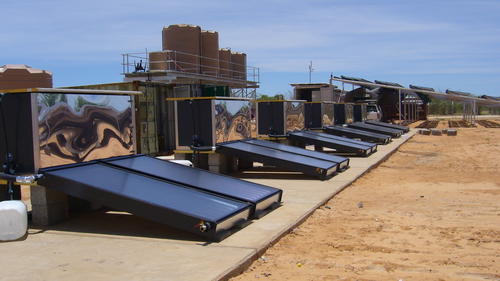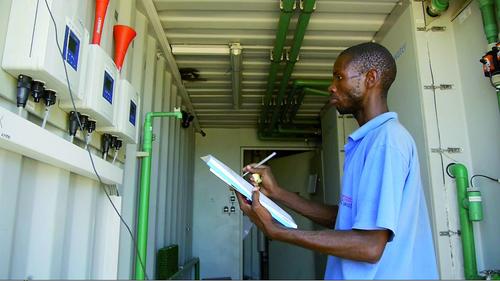Groundwater desalination
To provide remote areas with clean and healthy drinking water, the project has installed four innovative desalination pilot plants in the two villages of Amarika and Akutsima (Omusati region). Supplying peripheral rural areas decentrally with water is a very challenging task. Thus, the research focusses on the adaptation and operation of high-tech plants in remote areas. People from the villages were trained to take care of the plants and are responsible for their protection. In October 2010, the plants were officially inaugurated by the former Honorable Deputy Minister of MAWF, Petrus Iilonga.
Small-scale solar-driven groundwater desalination
Since the region has up to 300 days of sun per year, all the plants are powered by solar panels. The plants operate free of chemicals, producing between 0.5 and 3.3 m³ of safe drinking water per day.
Plants in Akutsima
- An evaporation plant with plastic heat exchangers which can produce up to 5 m³ water per day (Terrawater)
- A multi-stage desalination plant with plastic-metal composite construction which produces about 0.5 m³ water per day (Ingenieurbüro für Energie- und Umwelttechnik IBEU and Solar-Institute Jülich SIJ)
Plants in Amarika
- A reverse osmosis plant with electrochemical pretreatment which produces up to 5 m³ water per day (pro|aqua)
- A membrane distillation plant which produced about 0.8 m³ water per day (Fraunhofer Institute for Solar Energy Systems ISE). Since this plant could not stand up to Namibian conditions, it was dismantled
Read more about the success factors for implementation of this method as well as the achievements documented within the CuveWaters project.
3.5.3.3 Rainwater harvesting
In CuveWaters, facilities for rainwater harvesting have been piloted in the village of Epyeshona, near Oshakati, since 2009. During the short rainy season, rainwater is harvested on rooftops and concrete surfaces. It is stored in tanks made of different materials. The harvested water is of fairly good quality and is mainly intended for gardening purposes, but can also be used for washing, cooking or watering livestock. Gardens with water-saving drip irrigation systems were established next to the tanks. As part of capacity development, the project provided training and enabled local people from the village to build, operate and maintain the facilities. Furthermore, people have learned to cultivate and manage gardens, and to make profits from the yield.
CuveWaters is testing two technical and organisational options for rainwater harvesting: the household and the communal approach:
The household approach
In the household approach, water is harvested from the roof of three single households and stored in above-surface tanks made of different materials, namely ferrocement, bricks and polyethylene. All tanks in this category have a useable volume of 30 m³.
The communal approach
The communal approach comprises five different households that work together. It consists of an underground tank, a covered pond, a greenhouse and an open garden area. The greenhouse and parts of the outside garden are jointly operated, meaning that the farmers equally share their work and their gain. Additionally, every farmer has an own lot, which can be used for self consumption or market production of fruits and vegetables. Advantages of greenhouses are the prevention of evaporation, temperature control and the protection of plants from wind and pests.
Read more about the success factors for implementation of this method as well as the achievements documented within the CuveWaters project.

